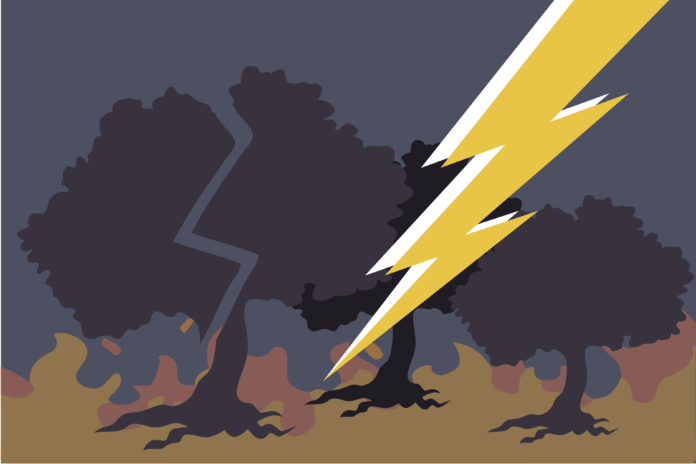Frequency of lightning, lack of precipitation are other factors that helped ignite some of the 700 wildfires across the state
In the last few weeks, Northern California has been set ablaze by nearly 14,000 lightning strikes, leading to thousands of residents being evacuated and some of the largest wildfires in California’s history. The sheer number of lightning strikes, lack of precipitation and hot and dry weather conditions — the latter which has been attributed directly to global warming and climate change — are all contributing factors in spreading these devastating wildfires that have burned over 1.38 million acres in California.
Many of the wildfires were ignited early in the week of Aug. 16, 2020, when storms passed through Northern California bringing little precipitation and lots of lightning. Erwan Monier, an associate professor who studies climate change impacts, described how this storm was formed by moisture colliding with a high pressure system, leading to precipitation that evaporated while still in the air.
“It was so hot and so dry that the [precipitation] did not have an opportunity to actually reach the ground,” Monier said. “If it had, it [could] have given some moisture to vegetation, and it would have helped extinguish some of the fires, [at least] some of the small ones.”
Monier referred to this phenomenon as dry lightning, which can be an effective instigator for wildfires when occurring alongside other conditions, like warmer temperatures and low humidity.
Paul Ullrich, an associate professor who studies regional climate modeling, explained that this lightning storm, like many individual weather events, can not be statistically linked to climate change, although the impacts of an event may be intensified by it.
“Inevitably, when it comes to infrequent events such as this and other forms of extreme weather events, you can say very little about climate change influences because you usually have such a small statistical sample,” Ullrich said. “The event in question — this major lightning storm event that did move through California — was certainly an unusual event, and one with widespread effects.”
He added that the dry and hot conditions which helped spread the wildfires can be traced as a more direct connection to climate change.
“It triggered fires primarily because it had taken advantage of already dry conditions that arose from a pretty dry spring season as well as high temperatures,” Ullrich said. “The temperatures themselves we can very clearly associate with climate change. That has led to drying of vegetation that is priming the fire for these types of events.”
Besides creating conditions favorable for igniting wildfires, warmer temperatures can become especially problematic for fighting a fire at night, when firefighters cannot rely on colder temperatures to hinder the fire, according to Monier.
“The nighttime temperatures have increased as well with climate change,” Monier said. “Generally, you have a cycle where you have cooler nights which slows down the spread of wildfires, but when you actually have nighttime temperatures that are quite warm, you lose this slowdown so wildfires expand even more.”
Another predicted impact of climate change is a shortening of the precipitation window in winter. Monier explained how California’s wet season is predicted to start later in the fall and end earlier in the spring, leading to a longer and more extreme dry season that can stoke wildfires.
“The expectation is that the window of precipitation in the winter is going to shrink,” Monier said. “That does not necessarily mean that over the entire year we’re going to get more or less precipitation, it’s just the timing is going to be shorter, and therefore you’re going to have more intense precipitation.”
California has a Mediterranean climate which consists of very wet winters and very dry summers. Ullrich said that as climate change progresses, this extreme is only going to be exacerbated with less and less moderate years — an effect called increased variability.
“Mainly, our dry extremes are going to become more extreme, and our wet extremes are going to become more extreme and occur more often,” Ullrich said. “That middle ground of moderate climate — moderate years — is going to slowly disappear. We are going to end up always living in the extreme, per se.”
Monier said this concept of increased extremes can be a challenging concept to grasp, as California is going to experience more wet extremes and dry extremes simultaneously.
“It’s more timing than the amount [of precipitation], which is why what we’re expecting, which some people struggle with, is more intense flooding and more intense drought at the same time,” Monier said. “Because precipitation will fall in a much shorter period, you’ll get a much longer period without rain.”
Written by: Madeleine Payne — science@theaggie.org




